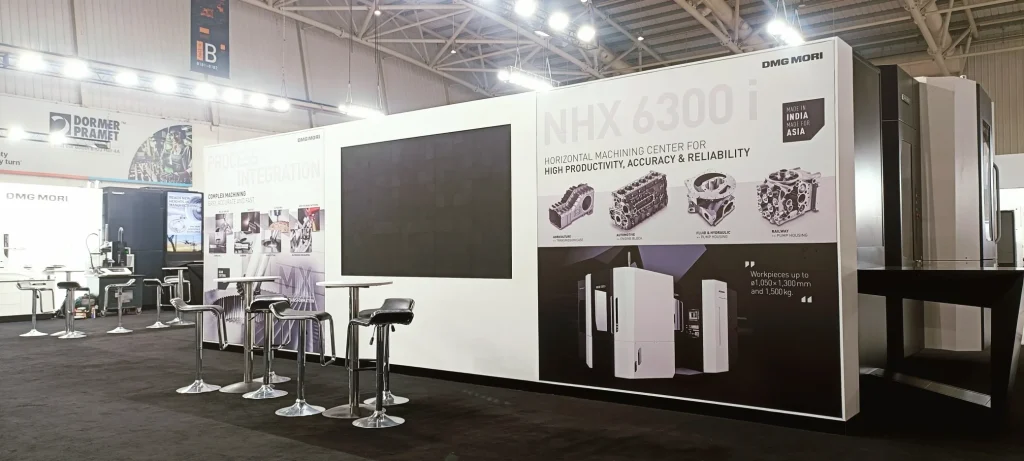
Introduction
As sustainability becomes a driving force in many industries, trade show exhibits are no exception. The need to reduce environmental impact has led to innovative approaches in booth construction. From using recycled materials to harnessing solar energy, companies are finding creative ways to make their exhibits eco-friendly.
This blog explores these sustainable innovations, highlighting their benefits and providing practical tips for implementing them in trade show booth design.
The Importance of Sustainable Booth Construction:
Environmental Impact:
Traditional booth construction often involves materials that are used once and then discarded, creating significant waste. By adopting sustainable practices, companies can minimize their carbon footprint, reduce waste, and promote a more eco-friendly approach to exhibitions.
Consumer Expectations:
Modern consumers are more environmentally conscious and prefer to support brands that share their values. Sustainable booth construction can enhance a company’s image, attracting like-minded attendees and setting a positive example within the industry.
Innovative Sustainable Practices
1. Recycled and Recyclable Materials
- Using Recycled Content
One of the most effective ways to create a sustainable booth is by using recycled materials. This can include everything from reclaimed wood and metal to recycled plastics and fabrics. These materials can be used for constructing the booth’s framework, panels, and furniture, reducing the need for new resources.
- Recyclable Components
Designing booths with recyclable components ensures that materials can be reused or repurposed after the event. This includes modular systems that can be easily disassembled and reconfigured for future use, minimizing waste and extending the life cycle of the booth components.
2. Eco-Friendly Fabrics and Finishes
- Sustainable Fabrics
Using eco-friendly fabrics for booth displays, banners, and upholstery is another key step. Organic cotton, hemp, bamboo, and recycled polyester are some of the sustainable options available. These materials are produced with lower environmental impact and can be recycled at the end of their life cycle.
- Low-VOC Paints and Finishes
Volatile organic compounds (VOCs) in paints and finishes can harm both the environment and human health. Using low-VOC or VOC-free products for booth construction helps maintain indoor air quality and reduces the booth’s environmental impact.
3. Energy Efficiency
- LED Lighting
Traditional lighting can consume a significant amount of energy. Switching to LED lighting for booth displays and accents not only reduces energy consumption but also provides better illumination with lower heat output. LEDs have a longer lifespan, reducing the need for frequent replacements.
- Solar Panels
Integrating solar panels into booth design is a powerful way to generate clean energy on-site. Solar panels can power lighting, electronic displays, and other booth features, significantly reducing the booth’s reliance on grid electricity.
4. Sustainable Flooring Options
- Recycled Flooring
Flooring options made from recycled materials, such as reclaimed wood, recycled rubber, or carpet tiles made from recycled fibers, can enhance the sustainability of a booth. These materials are durable and often have a lower environmental impact compared to traditional flooring options.
- Rentable Flooring Solutions
Renting flooring materials instead of purchasing new ones for each event can also reduce waste. Many companies offer high-quality, reusable flooring options that can be tailored to fit various booth designs.
5. Green Wall Installations
- Living Walls
Incorporating living walls, or green walls, into booth design adds a natural element that can enhance aesthetic appeal and improve air quality. These installations involve growing plants on vertical surfaces, creating a vibrant, eco-friendly backdrop.
- Artificial Green Walls
For lower maintenance options, artificial green walls made from recycled materials can mimic the look of living walls while still contributing to a sustainable booth design.
Benefits of Sustainable Booth Construction
1. Environmental Impact
- Reduced Waste
Sustainable booth construction practices significantly reduce waste by using recyclable and reusable materials. This minimizes the amount of waste generated during both construction and teardown.
- Lower Carbon Footprint
By incorporating energy-efficient features and renewable energy sources, sustainable booths contribute to a lower carbon footprint. This aligns with global efforts to combat climate change and promotes responsible resource management.
2. Brand Reputation and Engagement
- Positive Brand Image
Adopting sustainable practices can enhance a company’s reputation, demonstrating a commitment to environmental responsibility. This can attract eco-conscious attendees and stakeholders, fostering positive brand associations.
- Increased Engagement
Sustainable booths often incorporate innovative design elements that engage visitors more effectively. Features like interactive green walls or solar-powered displays can create a memorable experience, encouraging longer visits and deeper engagement.
Practical Tips for Implementing Sustainable Booth Innovations
1. Plan Ahead
- Sustainable Goals
Set clear sustainability goals for your booth construction project. Identify key areas where you can incorporate eco-friendly materials and practices, and plan your design accordingly.
- Budgeting
Allocate budget for sustainable materials and technologies. While some eco-friendly options may have a higher upfront cost, they can lead to long-term savings and benefits.
2. Collaborate with Eco-Friendly Vendors
- Supplier Partnerships
Work with suppliers and vendors who prioritize sustainability. Many companies specialize in providing eco-friendly materials and services for trade shows and exhibitions.
- Certifications
Look for vendors with certifications such as LEED (Leadership in Energy and Environmental Design) or other recognized green building standards. These certifications ensure that their products and practices meet high sustainability criteria.
3. Educate Your Team
- Training
Educate your team about the importance of sustainability and the specific practices being implemented in your booth construction. This ensures that everyone is aligned and committed to the project’s sustainability goals.
- Best Practices
Share best practices and success stories from previous sustainable booth projects. This can inspire new ideas and approaches for your current and future projects.
Conclusion
Sustainable innovations in booth construction, from using recycled materials to integrating solar panels, are transforming the exhibition industry. These practices not only reduce environmental impact but also enhance brand reputation and engagement.
By planning ahead, collaborating with eco-friendly vendors, and educating your team, you can successfully implement sustainable booth innovations and lead the way in responsible exhibition design. Embracing sustainability in booth construction is not just a trend but a crucial step towards a more sustainable future for the industry.


 US
US
 EU
EU


